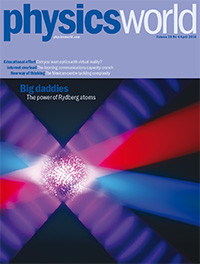 By Matin Durrani
By Matin Durrani
The April 2016 issue of Physics World magazine is ready and waiting for you to access via our app for mobile and desktop.
Our cover story this month is about Rydberg atoms – those super-sized atoms that are one of the hot topics in condensed-matter physics – and in particular how they could be used to create quantum computers.
You can also find out how virtual-reality tools could help you to learn about the science of optics and learn more about a new research centre at the National Autonomous University of Mexico that’s bringing a fresh approach to the science of complexity.
If you’re a member of the Institute of Physics (IOP), you can now enjoy immediate access to the new issue with the digital edition of the magazine in your web browser or on any iOS or Android mobile device (just download the Physics World app from the App Store or Google Play). If you’re not yet in the IOP, you can join as an IOPimember for just £15, €20 or $25 a year to get full access to Physics World digital.
For the record, here’s a run-down of what else is in the issue.
• Iranian physicists slam US visa law – Scientists are scrapping travel plans to Iran following new US visa rules, as Edwin Cartlidge reports
• Storytelling matters – Robert P Crease finds lessons for the history of science in a
religious holiday celebrated this month
• Boosting bandwidth – While physics could provide the answer to a looming capacity crunch in communications, Andrew Ellis says we first need to think about what society needs before solving the issue
• The rise of Rydberg physics – Quantum computers of the future could operate via the energy transitions of excited atoms, or even from pure light, if a rapidly growing area of atomic physics continues to meet with success, writes Keith Cooper
• Complex interactions – Complexity science – which describes phenomena such as collective and emergent behaviour – is the focus of a new centre where researchers are examining everything from the spread of influenza to what a healthy heartbeat looks like. Sergio de Régules reports
• Better than reality – Can you learn optics better using a simulation than you can in real life? Jon Cartwright explores how scientists are forgoing reality by replacing mirrors and lenses with virtual facilities and classrooms
• Making space for nonlocality – James Millen reviews Spooky Action at a
Distance: the Phenomenon That Reimagines Space and Time – and What It Means for
Black Holes, the Big Bang and Theories of Everything by George Musser
• Stand out in the scientific job market – Marc J Kuchner reviews The Professor Is In: the Essential Guide to Turning Your PhD Into a Job by Karen Kelsky and Networking for Nerds: Find, Access and Land Hidden Game-Changing Career Opportunities Everywhere by Alaina J Levine
• Industry fusion – Steven McNamara from Tokamak Energy reflects on the lessons learned during an industry-supported PhD in nuclear fusion
• Once a physicist – meet Heidi Allen, the British Conservative Party politician and the member of parliament for South Cambridgeshire
• On the naming of things – Gareth Leyshon looks at some of the strange conventions for naming astronomical objects
The Rydberg spherical atoms, because of their large radius have very high dipole moment couple strongly with the quantum vacuum needed in many fields such as the EM-quantum cavities.
Rydberg physics together with the development of laser techniques provides scientists many possibilities of realizations of quantum computing, quantum information and quantum simulation base on the exaggerated properties and strong interactions of Rydberg atoms.